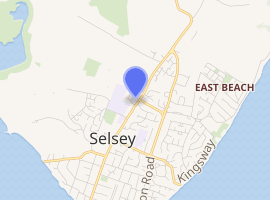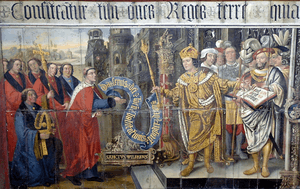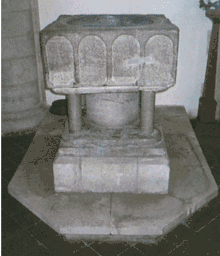St Peter's Church, Selsey
St Peter's Church is the Parish Church of Selsey, West Sussex and dates from the 13th century. The Church building was originally situated at the location of St Wilfrid's first monastery and cathedral at Church Norton some 2 miles north of the present centre of population.[1]
| St Peter's Church | |
|---|---|
The church from the south-southeast | |

| |
| 50.7369°N 0.7884°W | |
| Location | High Street/St Peter's Crescent, Selsey, West Sussex, PO20 0NP |
| Country | United Kingdom |
| Denomination | Church of England |
| Website | http://www.stpetersselsey.com |
| History | |
| Status | Parish church |
| Founded | 13th century |
| Dedication | St Peter |
| Architecture | |
| Functional status | Active |
| Style | Norman with Victorian Chancel |
| Administration | |
| Parish | Selsey |
| Deanery | Chichester |
| Archdeaconry | Chichester |
| Diocese | Chichester |
| Province | Canterbury |
| Clergy | |
| Priest(s) | Fr Andy Wilkes (from 22.7.15) |
History

According to Bede, St Wilfrid, the exiled Bishop of York, c. 680–81 evangelised the South Saxons during his stay there (c. 680–86).[2] Wilfrid founded a monastery at Selsey, a former royal estate given to him by King Aethelwealh at the entrance to Pagham Harbour (modern-day Church Norton).[3] After Caedwalla conquered the South Saxons c. 685, the area became part of the Diocese of Wessex, with its seat in Winchester. However, the bishopric of Sussex was re-established in about 705, and Wilfrid's monastery was taken over as the episcopal seat.[4]
A picture painted by Lambert Barnard, which hangs in Chichester Cathedral, represents the interview between Caedwalla and St Wilfrid. In the top left corner can be seen a representation of Selsey Church and the priory as it appeared in 1519.[3] It is probable that the bell tower, shown separate from the church on the Barnard painting, dated from the 11th century or earlier was constructed as some sort of fortification and not actually part of the church. A churchwarden's presentment[lower-alpha 1] from 1662 stated "That there was never any steeple belonging to the church (at Selsey), but a tower formerly belonging to a ruined castle, somewhat remote from the church where the bells hung...". An excavation of the mound in 1911 discovered the foundations of a square tower and the remains of a ringwork that would have supported the tower. It seems that the old tower lasted till 1602 when it blew down. A replacement tower was constructed, this time attached to the church, in 1662.[6]
In 1075, the See was transferred to Chichester. The location of the old Selsey cathedral is not known for certain, and although some local legends suggest it is under the sea, and that the bell could be heard tolling during rough weather, it is thought unlikely.[7] A more likely explanation is that the replacement church, founded in the 13th century, was built on the site of the old cathedral.[8][lower-alpha 2]
By the middle of the 19th century the population had drifted away to Sutton (modern day Selsey), largely because of coastal erosion. It was therefore decided to move the church to the new centre of population. In 1864–66 the church was dismantled stone by stone and re-erected in its present position where it was orientated North rather than East. The chancel remained at Church Norton and was dedicated to St Wilfrid in 1917 and is known as St Wilfrid's Chapel. [lower-alpha 3] A new Victorian chancel was added to the re-erected mediaeval nave.[10]The new parish church, complete with a new chancel, was consecrated on 12 April 1866.[11] The rectors continued to live in the rectory at Church Norton until a new rectory was built near the removed church in 1903. The old rectory was sold off and renamed Norton Priory. [12]
Building
The church originally stood at Church Norton, until the 19th century when it was moved to the current centre of population. Under ecclesiastical law, the church can be removed but not the chancel. So the old chancel was left.[13]
The church consisted of two arcades of three bays each between the nave and the aisles, of the late 12th century; it had barely been finished when it was decided to lengthen the church by one bay westward. The old chancel (which still remains at Church Norton) was of slightly later date, early 13th century. The date when the tower was begun is unknown. A sacristy or flanking chapel on the north of the chancel had disappeared before the 19th century.[13]

The old chancel has clasping buttresses at each east corner, a small buttress (apparently modern) near the west end of the north wall, and buttresses (the remains of the east walls of the aisles) to north and south of the west wall.[10] The new chancel added to the church, in its current position, is Victorian.[14]
The east window is of three trefoil-headed lights with Perpendicular tracery, perhaps late 14th century; the rear-arch may be that of a former lancet triplet.[10]
In the south wall are two pointed-headed niches with chamfered arrises, the eastern is now a credence, the western a piscina; though the style of these suggests a later date than the 13th century the original moulded string-course which runs round the south, east, and north sides of the chancel rises to clear them.[10] Next are two 13th-century lancets with segmental rear-arches, and a priest's doorway with plain pointed exterior arch, 13th century but much repaired with cement, and segmental rear-arch; this is now blocked externally, and its recess serves as a cupboard. Next is a two-light window without tracery, the lights having semicircular heads, perhaps a 17th-century enlargement to light a reading-desk, the inner part of the splay and the rear-arch being those of a 13th-century lancet.[10]
In the north wall are two lancets like those in the south; perhaps a third, now blocked, exists west of them. On the outside of this wall there is a weather-mould where the roof of a building adjoined it on the north.[10]
The church has a chalice dating from Elizabethan times and also an ancient font. The architect Ian Nairn, dated the font as being constructed at around 1100.[15] However, this was seen as a little early by other historians. The font, which is made of Purbeck marble, Heron-Allen suggests was of a type that was very common in the south east counties in the 12th century, having shallow bodies with circular basins standing upon a square base and supported by a large central and small angle shafts.[16] Architect Philip Mainwaring Johnston was responsible for the reredos.[17] The church is a Grade II listed building.[18]
See also
- Bishop of Selsey
- Bishop of Chichester
- List of current places of worship in Chichester (district)
Notes
- Churchwardens' Presentments are reports to the Bishop relating to parishioners' misdemeanors and other things amiss in the parish[5]
- By about 1200 almost every Anglo-Saxon Cathedral and abbey had been demolished and replaced with Norman style architecture, as a result no great Anglo-Saxon church has survived to modern times [9]
- It is currently in the care of a national charity, the Churches Conservation Trust.
Citations
- "Heron-Allen. The Parish Church of St Peter on Selsey Bill Sussex". Moore and Tillyer p. 6
- Bede, Ecclesiastical History of the English People, 731 AD, Translation Leo Sherley-Price. Penguin Classics (1955) ch.13 ISBN 0-14-044565-X
- Heron-Allen. Selsey Historic and Prehistoric. Duckworth (1911).p. 109
- Mee, A History of Selsey, Phillimore (1988). p.13 ISBN 0-85033-672-4
- The Canons of the Church of England. G6. p. 165.
- F. G. Aldsworth. 'The Mound' at Church Norton, Selsey in Sussex Archaeological Collection Vol. 117 pp. 103–107
- "Heron-Allen. The Parish Church of St Peter on Selsey Bill Sussex". p. 6 Moore and Tillyer
- Heron-Allen. Selsey Historic and Prehistoric. Duckworth (1911).pp. 105 -106
- Michael Wood. The Doomsday Quest. p. 141
- "Selsey, A History of the County of Sussex: Volume 4: The Rape of Chichester" (1953), pp. 205–210. URL: http://www.british-history.ac.uk/report.aspx?compid=41746 Date accessed: 12 August 2009 – Description of church building.
- "Heron-Allen. The Parish Church of St Peter on Selsey Bill Sussex". p. 10 Moore and Tillyer
- Heron-Allen. The Parish Church of St Peter. p. 18.
- Heron-Allen. The Parish Church of St Peter. pp. 6–7
- Heron-Allen. The Parish Church of St Peter. pp. 10–11
- I. Nairn and N. Pevsner, The Buildings of England: Sussex. Harmondsworth 1965, pp. 319–20.
- Heron-Allen. Selsey Historic and Prehistoric. Duckworth 1911.p. 185
- Allen, John (28 March 2013). "Architects and Artists I–J–K". Sussex Parish Churches website. Sussex Parish Churches (www.sussexparishchurches.org). Archived from the original on 16 May 2013. Retrieved 16 May 2013.
- Historic England. "THE PARISH CHURCH OF ST PETER, SELSEY, CHICHESTER, WEST SUSSEX (1026266)". National Heritage List for England. Retrieved 5 May 2020.
References
- Aldsworth, F. G. (1979). "Sussex Archaeological Collections Vol. 117: The Mound at Church Norton, Selsey, and the site of St Wilfrid's Church". Lewes, Sussex: SAC. ISSN 0143-8204. Cite journal requires
|journal=(help) - Bede Venerablis; translated by Leo Sherley-Price (1988). A History of the English Church and People. Penguin Classics. ISBN 0-14-044042-9.
- The Canons of the Church of England. 6th Edition (2000). London: Church House Publishing. ISBN 0-7151-3842-1.
- Heron-Allen, Edward (1911). Selsey Bill: Historic and Prehistoric. London: Duckworth. OCLC 14065805.
- Heron-Allen, Edward (1943). The Parish Church of St Peter on Selsey Bill Sussex 2nd Edition. Chichester: Moore and Tillyer. – booklet produced by the author(1st Edition 1935) for visitors to St Peters church.
- Mee, Frances (1988). A History of Selsey. Chichester, Sussex: Philimore. ISBN 0-85033-672-4.
- Nairn, Ian (1970). Buildings of England New Impression Edition. London: Penguin. ISBN 0-14-071028-0.
- Richardson, W.A.R. (2000–2001). "The Owers, Les Ours, Weembrug and 'The Old City' : place-names, history and submarine archaeology". Journal of the English Place-Name Society. 33. The English Placename Society. pp. 55–114. OCLC 893447698.
- Salzman (1973). Salzman, L.F. (ed.). The Victoria History of the County of Sussex: Volume Four :The Rape of Chichester (Facsimile ed.). Chichester, Sussex: Boydell & Brewer. ISBN 0-7129-0588-X.
- Wood, Michael (2005). The Doomsday Quest. London: BBC Books. ISBN 0-563-52274-7.
External links
- St Wilfrid's Bognor- Picture from North Transept of Chichester Cathedral showing St Wilfrids Interview with Caedwalla
